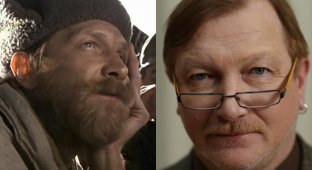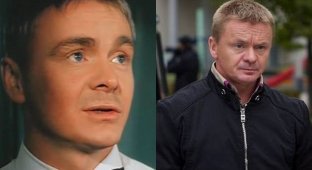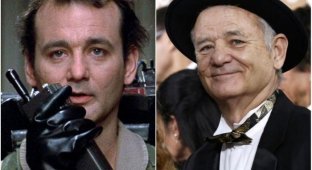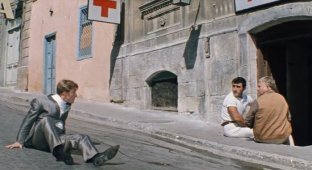Favorite comedies of our childhood: “Peculiarities of the National Hunt” and its sequel.
Russian-made comedies are something that is especially dear to our souls. Often the most successful paintings are then “stretched” into quotes, played at certain periods to lift the mood... Of the most cult, “hit”, classic - “Features...” Hunting, fishing and so on. As is usually the case, the first episodes are still a little more famous and brighter.
Previous part.
Peculiarities of the National Hunt

"Fenik", a young Finnish specialist in the field of hunting, decides to better learn the customs and habits of Russian hunters. To do this, he convinces his Russian friend to take him hunting with him - to learn from the Russians, to understand their mentality. This is where the fun begins: constant feasts and the adventures that “follow” from them are not exactly what the Finn expected, but over time he begins to like this turn of events more and more... He is especially inimitable in one of the main roles (General Ivolgin) - Alexey Buldakov. He managed to create a surprisingly charming image. One of his “highlights” is his laconicism when making toasts: “Well, to beauty!”, “Well, to justice!”, “Well, to fishing.” Our dads often repeated these toasts later during feasts. And in general, this film is full of various kinds of “pearls” that have become winged.

“Well, damn it, you give me…” - once.
“You are under arrest! - Do you have a pistol? “Then they are detained,” two.
“Yes... If you want to live, you won’t get so excited...” - three.
We could go on for a very long time. Features of national fishing

“Peculiarities of... fishing” (1998) also has its own, excuse the pun, peculiarities. Some people like this film even more than the first one, about hunting. In terms of the density of “catchphrases”, the thoughtfulness of dialogues, remarks and even the facial expressions of the characters, “Peculiarities of National Fishing” can be put on a par with Soviet comedies, for example the same Gaidai. What is the value of at least the famous: “I’m on a log, and you’re in Cyprus?!” Or this: “Don’t pee in the glass! “And this is exactly what I want!”

Again, concise and funny General Ivolgin, natural, natural in any situation Leva Soloveichik... Kuzmich is simply inimitably “one of our own”, but somewhat aloof. Both Seryoga and Semyonov look very funny, and in general the film constantly keeps the viewer glued to the screen, never allowing them to rest from laughing. The acting group did an excellent job. They just say that, as often happens, Alexey Buldakov, after the premiere of one of these films, said about the audience in the manner characteristic of his hero: “Oh, I don’t understand why they are laughing...” Of course, the films in this series confuse a little sober image lovers life. But what can you do if the life of Russian fishermen and hunters is depicted here exclusively in a natural way? All these “features” fit perfectly into one simple anecdote: “Don’t know how to fish? What can you do - pour it and drink it!” Yes, I also have conflicting feelings when watching it: you understand that all this is funny only in the film, but in life it’s very sad. But maybe this is what screenwriter and director Alexander Rogozhkin wanted? And even if it didn’t, then this film, like any work of genius, may well accomplish something special in the minds of each of us. Special and individual depending on who is tuned in and how they are raised. I don’t want to touch other films from the “Features” series just yet... Opinions about them are somehow too contradictory. However, the two films mentioned here can definitely be classified as classics of Russian cinema of the 90s.
American comedies of our childhood: “Home Alone”, “Problem Child”, “The Mask”, “Beethoven”.
It just so happened that as a child I loved football and laughing, which was reflected in the choice of my favorite programs and films. And, although football was often a reason for laughter, sometimes (in the off-season, for example) comedies really helped out. Even a no brainer, perhaps, it is clear that Gaidaev’s films were in favor even then, but here let’s remember, first of all, the American comedies of the 90s. Those that were filmed then came to television screens and decorated our childhood with vivid emotions.
Of course, American humor in general sometimes seemed a little stupid to us. Roughly speaking, when a cake hits someone in the face or when someone falls into a puddle of mud, Americans laugh, but in most cases we do not experience any emotions other than bewilderment. It is worth noting that stylish humor can also be found in American films. Moreover, although he is not devoid of a certain amount of intelligence and charm, he often shows his national traits in all their glory: falls, comical situations, misunderstandings associated with them... One of the most striking examples is the series of films “Home Alone”, especially the first parts with Starring Macaulay Culkin.
Alone at home

The first part (filmed in 1990) developed like this. A typical American family, only with many children, goes for the Christmas holidays from Chicago to Europe. However, in their haste, clueless parents forget to take with them... one of their children. The boy - what a wonderful creature - in such a situation not only does not get lost, but even prevents the robbery of a couple of robbers, demonstrating miracles of ingenuity. First he tries to prevent them from entering the house. And when the robbers manage to get there, they have to regret such a meeting three hundred times over. The tricks of this “baby” looked very funny and unusual. In the second part (1992) and the third (1997), the plot develops in a similar way, but has some features dictated by time. Nevertheless, as someone correctly noted, the New Year for us (unlike our parents, who were intoxicated by the “Irony of Fate”) was incomplete if Kevin was not forgotten at home. And since we often forgot it, we were guaranteed a good mood during this period =)

The fourth part, completed later, did not seem to arouse such interest.
Difficult child

In the comedy film “Problem Child” you can find something similar (humor, the image of the main character). Yes, American children at that time were no longer a gift. But in “Problem Child” (several parts of this film were also shot) a lot of interesting, topical problems were really touched upon. Let me briefly recall the plot. Ben Healy and his wife Flo, trying to break into high society, adopt a charming seven-year-old boy, Junior. However, they soon notice that in fact it is a small monster that manages to turn a vacation, a holiday, and even a baseball game into a real nightmare. Of course, funny for the audience.
However, is this truly a fiend from hell, or has he simply not learned how to behave? Does he just want to attract attention? Will his adoptive parents be able to pay attention to his strengths and develop them, turning a blind eye to his tendency to commit minor and major hooliganism? These questions worried us as we watched.

Family life is described in the film in many ways, from interesting aspects. Everything is somewhat hyperbolic and exaggerated, but that’s why it’s interesting. Well, in the following parts the theme develops: Junior is jealous of his adoptive father for the woman with whom he begins to date, and then he falls in love and begins to eliminate competitors...
Mask

Particularly worth mentioning is a creep named Jim Carrey. In the 90s, he managed to win over a certain part of the Russian audience, which was generally indifferent to this type of humor.
In this film, which was filmed in 1994, the main character Stanley Ipkiss, a modest bank employee who feels insecure with girls, accidentally becomes the owner of a “mask” that has fantastic properties and makes him a superhero like Batman or Spiderman. This comedy brought Jim Carrey worldwide fame.
For Cameron Diaz, the role in the film was her debut.

Beethoven

In general, films with the participation of animals began to enjoy wild popularity in the 90s, and then they began to be made with high quality. But my warmest memories are the stories (also in several parts) about a St. Bernard dog named Beethoven. The picture is surprisingly kind and cheerful, and what gives it a special charm and comedy is the discrepancy between sympathies for this huge dog and the reluctance to be with her all the time. Yes, this tape evoked emotion even among the most callous “chumps.”

These films give me particularly pleasant feelings. Of course, many of you also remember them and probably look through them in your spare time.
The main “goodies”: favorite drinks of the 90s (part 3).
A separate topic for conversation is what we drank in the 90s. This is actually both a funny topic and partly sad. Again, some drinks were so harmful and disgusting that they were simply creepy, but it seemed to us that this was the height of pleasure.
We have already mentioned the dry drinks “Yupi”, “Zuko”, “Invite” and the like.

I remember how my father, who loved stronger drinks, said that Invite was too cloying. Of course, this outraged me. So what? But it was easy to prepare - just add water. However, the side effect of a tongue colored the color of the drink could indeed be classified as a disadvantage. Apparently, the fact that, according to the Yupi advertisement, the drink paints life in different colors, had to be interpreted exactly like that. But when we got a siphon at home to turn water into soda, it was possible to make even these terrible mixtures into what seemed like a pretty decent drink.
It’s much more pleasant to remember such concepts as lemon juice like “Tarragon” (my grandmother accidentally called it “shampoo” in the store), “Kremsoda” or “Pinocchio”. However, this is rather a Soviet legacy that reached the 90s. In principle, descendants vaguely similar to them still exist, but in the 90s the concept of “citro” seems to have sunk into oblivion. And replaced by a more universal one - “drink”.

And even more vivid memories of the Western drinks that appeared then. These are, first of all, Pepsi-Cola, Coca-Cola, Fanta, Sprite, Crush, Dr. Pepper”, etc. The first three, conquering the post-Soviet market, did not stand on ceremony: basically, they simply showed off their name. Well, maybe Pepsi also pleased with the presence of celebrities in the commercials - Spice Girls and Beckham, for example. And stories, of course. For example, it was funny about Beckham. There, in the commercial, in a match that was called unsuccessful for David, he goes as a substitute. On the way to the locker room, the guy asks him for a T-shirt, David smiles, gives it to him, after which he sees how he opens a can of Pepsi with its help and returns the T-shirt. Then his back is shown with the inscription “Juventus“.

And “Sprite” even declared that “image is nothing”, creating an image for itself, paradoxically, precisely on this phrase. The image of “Crush” was completely funny to the point of indecentness.

The guy tried to brake the car, but to no avail. After which he drank Crush and took off his pants. That is, while trying to stop the car, he turned his butt towards the drivers. I still wonder: what did they mean by this? “Crush is your color! Color of your life,” was the slogan, which meant in translation that this seems to be the color of our life. But many of those who have tried it rate the taste as completely natural. It was somewhat reminiscent of another famous drink - Mirinda. If we talk about taste, then I would still put Fanta in one of the first places.
A separate conversation is “Hershey-Cola”. The taste is ordinary. But how little Sasha Loye portrayed the “taste of victory” when the stupid-looking teacher announced the test results (“Sidorov! Three!”)! It was truly unforgettable, although the “educational” side of the video, I must admit, outraged many adults.

But what am I? We didn’t just drink fruity-chemical drinks like that. Teas were also consumed in the 90s. And then new ones appeared on sale - with all sorts of fruit additives. In general, there was a lot of variety. Therefore, their producers tried to “light up” in the intervals between the episodes of “Santa Barbara” and “Tropicana”. And for example, “Pickwick” tea pleased me by demonstrating how a strawberry before our eyes turns into a teapot, and delicious tea flows from there.

Well, alcohol is a separate issue. Of course, for us children, this topic was one of the “forbidden” topics. But “Rasputin” vodka with a “magic portrait” still excited our young minds. Many of us seriously thought that it would take Rasputin to actually wink: to get drunk or to somehow hold a bottle?

In general, it was very tasty to live in the 90s. And because of the drinks, too. I remembered it with pleasure.
The main “goodies”: chewing gum, “m&m`s”, “Chupa-chups”, “Frutella”, “Mentos”... (Part 2)
Of course, the delicacies of our childhood were not limited to chocolate bars. In the 90s, a huge number of products poured into the Russian market, which were already somewhat boring in the West. This category includes, for example, chewing gum, sucking lollipops like Chupa Chups and something else.
Let's think about chewing gum. Here again, the factor that activates the memory will be the same advertising of the 90s - so funny, so cute. After all, you must admit that many associations arise thanks to well-thought-out advertising slogans. Or funny melodies and stories.
After the Soviet “gums” that I managed to chew in early childhood - “Coffee”, “Mint” and so on - any American “buble gum” seemed much more “powerful”. Partly, however, their success was due to advertising.

So, one of the first chewing gums of our beloved 90s was “Wrigley’s Spearmint”.

It just had a really strong mint flavor. And the commercial (which I remember) demonstrated the superiority of this chewing gum in a very unique way: to a funny tune (“Wrigley-Spermint-gum-gum-gum…”) a man was carrying a box the size of half his height. “Take some minty freshness with you,” it said. Probably they wanted to show that this is a really large, serious manufacturer.
It seems that a little later “Stimorol”, “Dirol” and “Orbit” burst into the Russian market. Here more serious arguments already came into play, although, in essence, the difference with their predecessors in these chewing gums was small. Mint, fruity taste in some forms - all this was present, but was no longer the main thing.
“Stimorol” stimulated buyers mainly with stories related to gender relations. For example, one of the first advertisements depicted a situation on the road with the participation of police officers. For my childish mind the situation was rather complicated. There was no text as such, and it was not possible to grasp the subtleties of the plot development at that time. It is only clear that chewing gum in some mysterious way helped to attract the attention of a person of the opposite sex. In another advertisement, a couple in love slightly mocked the grandfather-seller. The guy, buying chewing gum, seemed to demonstrate his “coolness” and freshen his breath. And after that he started kissing the girl. Then grandpa tried to portray something similar with his wife, but she shook her head sympathetically. And only then “Stimorol” constantly emphasized kisses. I remember the concept of “place for kissing”, the phrase “Do you know what I need now?” and the answer: “Fresh your breath!”

For some reason, “Dirol” and “Orbit” remained inseparable in my mind, like twin brothers, like “Mars” and “Snickers,” like Lenin and the party. Some advertising moves of one company were immediately accompanied by similar actions on the part of competitors. Besides the fact that “Dirol” was “with xylitol and carbomite”, and “Orbit” was without sugar (!), it is difficult to remember anything original from all these videos. People with dazzling white teeth smiled at us in the frame while the voice of the announcer announced exactly what innovations and inventions help achieve this effect. And how they help in defeating the terrible enemy of humanity - caries. Although, of course, this was only help at that moment “when a toothbrush is not available.”

All of these chewing gums had a plus in terms of usefulness, but a significant minus in the “interestingness” column due to the fact that they were missing the favorite children's entertainment of the 90s - inserts. In this regard, at one time there was no competition in “Donald Duck” (comics about Donald were still very popular), “Love is...” (it combined a “sweet couple”: a banana and a strawberry - in the advertisement they ran away and hid in a block of chewing gum), “Turbo” (a dream for technology lovers), “Final” (just sweetened rubber, but they took it to watch their favorite football players!), “Bom-bim-bom”, “Cola” (yes, with an imitation of the taste of the drink ) and others.
In addition, in the 90s, Chupa Chups and m&m`s shorties became widespread."

They also added some variety to the assortment of “goodies”. The plots of the advertisements with them were somehow not memorable, but they were aimed at the youngest (I would say “small”) audience: cartoon stories, “childish” appeals. And, to be honest, it was difficult to get enough of them. Therefore, only children of primary school age went crazy about them. And then another original thing was launched for the same target audience: “Kinder Surprise”. It was said to combine three important phenomena: chocolate, a toy and a surprise. You can also remember “Frutella” (with which “we will smile together”), “Rondo” (a thing for freshening breath, also useful in various life situations) and “Mentos” (in the videos it helped make a “fresh decision”).
The last of the “goodies” I mentioned, despite everything, “caught on.” And yet I remember chewing gum with inserts with special nostalgia.
The main “goodies”: Mars, Snickers, Bounty, Twix, Milky Way, Picnic... (Part 1)
Well, there was no abundance of food in the Soviet Union. And in the 90s it appeared. The variety of all kinds of “goodies” was especially impressive. Yes, then a stream of things that our parents could only dream of “poured out” at us. These are, first of all, chocolate bars.
One of the first bars that I was lucky enough to try (that is, almost an ordinary chocolate bar, only it is packaged differently than “Alenka”, “Chaika”, etc. and is much thinner), was “Hilal” made in Turkey. It somehow “ended” quickly, because by the time you opened the wrapper, I was already drooling. And then - just “am”... And that’s it.
Of course, the fashion for such dystrophic “chocolates” quickly passed, as “Mars”, “Snickers”, “Bounty”, “Twix” and much more appeared in our lives. And they, unlike their predecessors, tried to surprise with something, to stand out from their competitors.
“Mars” put pressure on the fact that it contains “all the wealth and power of nature.”

Somehow its “inside” was described very vaguely in advertising videos, but the process of its production was very appetizingly demonstrated. And, of course, I was impressed by the words with which the producers “lured”: nougat, for example.
And “Snickers” immediately announced itself as a “bar” that amazingly combines “roasted peanuts and soft caramel.”
Peanuts are what we were missing before to fully enjoy the taste! And, of course, we instantly understood why we can’t live without Snickers: it turns out that sometimes there is no time to have lunch, to cook something tasty... And then he comes to the rescue. Ate it - and that's it! At the same time, of course, while eating Snickers, we simply did not know how important it is for a chocolate bar to also contain coconut. Only then, you know, does “heavenly pleasure” happen. There are simply no other options! Only the Bounty could complement your happiness.

Peanuts are what we were missing before to fully enjoy the taste! And, of course, we instantly understood why we can’t live without Snickers: it turns out that sometimes there is no time to have lunch, to cook something tasty... And then he comes to the rescue. Ate it - and that's it! At the same time, of course, while eating Snickers, we simply did not know how important it is for a chocolate bar to also contain coconut. Only then, you know, does “heavenly pleasure” happen. There are simply no other options! Only the Bounty could complement your happiness.

However, over time, something more was needed for happiness. For example, two bars at once in one package. Well, this is to share with a friend, for example. Or “take a break” with a casual acquaintance during difficult moments in life. Yes, we remember Twix for its interesting plots in commercials. And with your funny heroes. Moreover, inside this “yummy” there was only something like a cookie. And I still take it from time to time. For some reason I like it - and even without advertising.

And if this same aforementioned “sweet couple” can be considered a champion in filling pauses, then the Milky Way bar immediately became a champion in swimming. Yes, judging by the advertisement, it did not drown in milk, which, in theory, spoke of its “lightness” and “airiness.” But evil tongues immediately remembered that you don’t drown (in water or milk) you know what.

And yet, something was always missing. In this regard, “Lion”, “Vispa”, “Wagon Wheels” come to mind - lesser-known examples of “goodies” advertised in the 90s. One could choke on saliva when once again they showed us how someone chews this yummy, how they break it open and show off its “internals.” We envied those who starred in such videos and, as a rule, did not realize that these people, after another failed take, simply spat out what they were biting in the frame with such gusto. Without knowing this, we were ready to give up, if not everything, then a lot for the “chocolate treats.”

The best cartoons of all time: “Tom and Jerry”, “DuckTales”, “Chip and Dale”.
The best cartoons were shown in the 90s. Neither before nor after this period is it possible to find something equally interesting, educational and instructive for children. Does it sound categorical? Are the words “seemingly” or “in my opinion” missing? Don't rush to a conclusion. Now I’ll prove the statement in no time. Of course, one can make allowances for the fact that then, in the first half of the 90s, (almost no one) even had VCRs, let alone DVDs or the Internet. And that’s why cartoons were expected; they couldn’t just be turned on at will. However, they showed a lot, and that was what the children were waiting for. Specifically, I wanted to watch the good old “Soviet” cartoons and the best examples of foreign cartoons – the same “Disney” ones, for example. But stop. What does the Soviet Union have to do with the 90s? Here I just want to make an analysis of what we watched in the 90s - without reference to the time the cartoon was created. If we start from this parameter, we get a very interesting combination: the best cartoons of the past (the period when the script and the idea were in the foreground - all this was taken really seriously in the Union) and the first cartoons of the period of rapid technical progress - it was really Something. Just remember the favorites - the domestic Wolf and the Hare from “Well, wait a minute!”, as well as the “foreign” Tom and Jerry.

Of course, this is not an example of instructiveness. The genre of these animated series can be defined as comedic “catch-up games” with endless bullying of a weaker opponent over a stronger one. But even in this genre one can distinguish taste and bad taste. Let's say, if Wolf or Tom climbed where they shouldn't, then they got paid for it. Subconsciously, the audience tuned in to empathize – first with one character, then with another. However, these cartoons, although not without scenes with very painful injuries to the characters, did not seem to encourage violence, and even evoked sympathy to some extent. I would like to note that when the characters of the animated series “Tom and Jerry” became “younger” (in the late 90s there was some incomprehensible change in the image towards “shrinking”), it became extremely empty and stupid. As examples of the “classics of the genre” of Soviet animation based on foreign works, one can recall Winnie the Pooh and Piglet and (to a lesser extent) “The Three Musketeers,” whose “roles” were dogs and cats. What’s most amazing to me is how Soviet screenwriters, directors (and other workers who worked on such masterpieces) managed to make the best film adaptation of certain works of all times? And at the same time, it was something original, unique, living, as it were, separately from the literary work. A separate song is Walt Disney's animated series. We were looking forward to them in a special way. Even when we were playing football in the yard, our mothers shouted from the windows: “Go home! Walt Disney presents..." Back then, as far as I remember, they showed two episodes of different cartoons. First up is DuckTales plus Chip 'n' Dale Rescue Rangers. Then - “Miracles on Bends” plus “Gummi Bears”. The first couple seemed to me much more interesting and smarter. Shall we remember? DuckTales.

Billionaire Scrooge McDuck is a very charming, albeit greedy character, constantly swimming in gold (his “trick”), being greedy and raising his nephews Billy, Willie and Dilly with the help of a strange nanny - Miss Cluvdia. From time to time, good old Donald Duck and Mrs. Klyuvdia’s granddaughter, Ponochka, who came from nowhere, also appeared in the series. Somewhere nearby lived a stupid pilot, Zig-Zag, who loved to get into plane crashes, but always remained alive after them.

There were no less interesting negative characters: the brothers Gavs, Magica, Glomgold and others.

Chip and Dale.

A couple of chipmunks in shirts and hats, in company with Roquefort, Gadget and Zipper, are just waiting for problems to arise in the city (populated for some reason by half people, half animals like cats, moles, dogs, etc.). Why? Yes, because they really want to rush to help. And this is how funny it turns out: they are constantly doing weird things, being “stupid”, getting into the wrong places, but they invariably emerge victorious. However, Professor Nimnul, Tolstopuz the cat and others still return in other episodes with their next “nasties.”

I think it’s a good idea of the creators that the characters have a unique image: Chip is smart, Dale is stupid, but funny. Gadget “diluted” this male company with her seriousness and “brilliant ideas.” Well, Roquefort could only let his team down with his unbridled passion for cheese. “Seeyyyyy,” he shouted when he heard the smell he was looking for, and at the same time his mustache stretched out.

Yes, these are not empty fights, shooters or plots “about nothing” like today’s “bakugan” and “spongebobs”. There were meaningful stories, unique humor and, of course, instructiveness.
Humor of the 90s: politics, advertising, new Russians.
When the Soviet Union collapsed, comedians suddenly needed to change the topic of jokes, because the topics that worried people had changed. And if, for example, Gennady Khazanov declared a “crisis of the genre,” then Mikhail Zadornov and many others simply took advantage of the situation to somewhat update the repertoire. Moreover, for obvious reasons, jokes have become somewhat bolder.
What I would like to note when talking about the humor of the 90s is that it is more topical and sharp in comparison with the humor of the Soviet period. The “key” characters in the jokes also changed. If, according to the same Khazanov, in Soviet times people laughed at the “scarcity” of goods and various kinds of “excesses” of the existing system, then in the 90s humor became more specific, personal, so to speak. Yes, not everyone could afford to laugh at the fact that they had everything, but had no money to buy it. However, some could do it very charmingly. Here, for example, is a completely acceptable joke from Petrosyan that I remember: “We have never seen such abundance before. And now WE SEE. (Pause.) We go to stores as if on an excursion.”
It was fashionable to joke about politics. Often the same KVN players were accused of excessively “politicizing” their humor. However, it is worth saying that this circumstance was quite justified by the interest of the “public” in the topic of democracy, in the names of Russian politicians, who themselves were sometimes funny, and sometimes so serious that it was still funny. Another popular topic is commercials. Of course, few people could remain indifferent to Lenya Golubkov and financial pyramids, pads for “critical days” and the like. One comedian, I remember, even mixed up “Mars”, “Snickers” and “Tampax”. And Efim Shifrin delighted the audience with a mini-poem (something like blank verse) about advertising, which included, for example, a meaningful phrase about the Milky Way candy bar: “If it doesn’t sink in water...” Another common topic is the new Russians. This class of “bourgeoisie” that suddenly formed in the 90s worried many people like everything new. Of course, some for the banal reason of envy, others for other reasons. But the topic was interesting and funny. In programs (such as the “Gentleman Show”), the characteristic features of the “New Russians” were clearly demonstrated: crimson jackets, gold chains, “fingering”, specific slang with “articles” “type” and “specifically”.

The first word was jokingly called the indefinite article, the second - the definite article, by analogy with the English language. In jokes, they were usually portrayed either as smart representatives of their time, or as “dumb” and lazy, or as HPs simply finding themselves in comical situations. Here are a couple of examples to “refresh” the nostalgia. *
During a lesson in a class where New Russian children study, the teacher asks:
- Children who bought homework today, please raise your fingers! *
One day a new Russian attended the “Field of Miracles” program.
Some time after the start of the game, he got the “prize” sector.
A “black box” is brought into the studio, and Yakubovich immediately begins to bargain. But HP unexpectedly declares:
- I don’t want any money or a prize. Can I whistle into the microphone instead?
Yakubovich was shocked, but after thinking about it, he allowed it.
HP immediately takes the microphone and whistles, after which he gives it back. Yakubovich looks into the drawer and takes out the keys, announcing:
- You just “whistled” a VAZ-2110 car!
- Why do I need this jalopy of yours? - says NR, smiling. - Yesterday I made a bet with Vovan at the 600th MERS that I would whistle to the whole country. What amused me greatly was the “lifelike” nature of such situations and jokes. And a high degree of realism. Even the classic name “Vovan,” chosen perhaps simply as an alternative to “Vovochka,” had meaning for me, since that was the name of my rich classmate. You can remember the humorous series that appeared then. With particular nostalgia I remember “Cafe Klubnichka” - a very sweet and kind series.

However, during this period (and in this series - one of the first) a rather strange Western tradition was used - to include laughter behind the scenes. It seemed to tell the slow-witted viewer when to laugh. And this tradition (unfortunately, I would say) has taken root. In general, while some Russian comedians were experiencing a “crisis of the genre,” it was fashionable to copy Western programs: all kinds of “Jokes” (that is, filming practical jokes with a hidden camera) and magazines like “Pun” we liked for some time, although later, it must be said, boring.

And it seems that this is good. Russian humor has already become more original. And yet I also remember the humor of the 90s with special nostalgia.
Games on Sony Playstation: dreams come true.
Needless to say, playing on Sonya in the 90s was a dream. Then, perhaps, only the children of the richest, for example, the same “new Russians,” could afford it. At least, this was the case in the Ukrainian provinces - in the capitals, the console was probably more accessible. I once mentioned that I had the opportunity to play on a 32-bit with my “rich” classmate. I remember how I dreamed that I would again get to see him for a few hours... And how quickly these hours flew by, which seemed like just minutes.
Here I’ll just try to remember a couple of games that were very typical for that time. Games, something remarkable and with impressive graphics for those times. Resident evil 2

The second part of the cult series of games for Playstation and other gaming platforms. The story of the zombie invasion of the small town of Raccoon City was so interesting and at the same time scary that it was impossible to tear yourself away from it for a minute.

It was Resident evil 2, released in 1998, that became the progenitor of all zombie shooters, and the most spectacular scenes from this game ended up in the film “Resident Evil: Apocalypse”. Although now the game does not amaze with its graphics and level of realism, in the distant 90s it was considered a masterpiece of the horror industry. How scary it was when hordes of zombies began to jump out from around the nearest corner onto a completely deserted street, or hundreds of hands of bloodthirsty dead began to reach out from the walls of a tightly closed police station room towards the main character! Among the features of the game (which attracted schoolchildren) we can mention not only excellent action and the oppressive atmosphere of the locations, but also a large number of weapons and auxiliary items. For example, various potions could be made from special colorful plants. Also in the game you constantly had to solve intricate puzzles. This was necessary to get into one or another room. It is also impossible not to mention the very dramatic and heartbreaking story about the zombie invasion in Raccoon City, which was revealed to the player on the pages of various diaries and work notes, appropriately hidden in different locations of the game.
Tekken 3

Another famous and, so to speak, “cult” game that I would like to remember is Tekken. Then, in the 90s, this name was, as they say, “well-known” among “gamers”.
The third installment of the popular fighting game series was first released in 1997 for arcades, but since 1998 it has been available to play at home on a 32-bit console. Again, now we treat this kind of “toy” more coldly. For some reason, I wouldn't play this (and many other games from the 90s) now. But then... Then, even despite the fact that after Tekken 3 quite a lot of sequels were released of much better quality and for more modern consoles, it was this part of the game that was recognized by gamers around the world as “the greatest “fighting game” of all time.” And it’s hard to argue with this: a huge selection of characters, good, even by modern standards, graphics, amazing and varied tricks, an interesting plot - what else is needed for happiness? Each character was different from the other not only in appearance, but also in the manner of moving, striking, and fighting style. In Tekken 3, it was possible to pit not only a karateka and a professional wrestler, but also a bear with a small dragon or a wooden “Pinocchio” with an alien samurai in a heated fight.

Also, Tekken 3 was almost the first three-dimensional fighting game in which the ability to dodge blows was implemented. And so that the player does not get bored with endless fights, the game offered several additional modes. For example, you could choose a platformer mini-game, where the player was asked to go through four difficult levels and fight hordes of dark “ninjas,” or, choosing any two game characters, play beach volleyball with a friend.
I remember, playing with my school friend, I quickly “grabbed” “weak points” in several games, which I successfully used in the game against him. For example, in one such “fighting game”, having chosen a fighter with some kind of long stick for battle (we even nicknamed him or her after the name of our classmate - Klyushkina), I could “kill” the opponent by simply holding the hit button, in total in a few seconds. However, already in the 90s, the possibilities for this kind of tricks in most games were eliminated. Moreover, then any “layout” (easy to play or difficult) was received with a bang. And this is not surprising. After all, it was a dream after all. A dream that so unexpectedly became a real reality.
Sports: continuation of Soviet traditions.
Speaking about what sports was like in the 90s, I want to draw attention to one, as it seems to me, defining touch. The collapse of the Soviet Union led to the fact that the sport became professional, but this more likely affected the motivation of athletes than on the general level. Their basic class was determined by two factors: the “Soviet” spirit and attitude (“we are the best and must prove it,” “we are the best, but we are being judged,” etc.) and the post-Soviet level of motivation: money, honor. In general, in theory, a good combination. However, there is one “but”: poor training bases that had to be created almost from scratch. Therefore, as a rule, it was a struggle between the sports spirit and external factors.
I started following football more or less actively in 1994, with the World Cup in the USA.

Then Russia found itself in a group with Brazil, Sweden and Cameroon. Having lost the first two meetings, the team entered the game with the Africans in an amazing mood. And they won 6:1, with Oleg Salenko scoring five goals at once. It was something unforgettable, but in this development of events, it seems to me, one of the main traits of athletes throughout the post-Soviet space was revealed: first create problems for yourself, and then heroically overcome them. By the way, another funny detail: often after Russian athletes had lost almost all chances of success, they did everything possible to advance further, but were forced to rely on some other factors. And this case is no exception. We should have expected that the teams in other groups would “help” us by playing in such a way that at least two of the teams that took third place, like Russia, would turn out worse. But only the Korean team turned out worse, and the Russian team, having scored 3 points and having a positive goal difference, went home. Again America was to blame =). Russia desperately tried to participate in further major football tournaments, but this did not always work out. And the team did not manage to get out of the group (for example, at Euro 96). And at the very end of the 90s (1999), in the selection for Euro 2000, the Ukrainians were included in one qualifying group for Russia, who, in turn, showed their characteristic feature: I don’t make noise myself and I won’t give it to anyone else. Russia’s path looked like this: under coach Byshovets, it lost the first three games, and after his resignation, under Romantsev, it won everything. Until the last match with Ukraine, where she only needed a victory. The latter, by the way, also had plans for Euro 2000. However, since France was the leader of the group, Ukraine could also get there only through the playoffs. However, a draw gave such an opportunity to the Ukrainians, who were slightly ahead of their northern neighbors. Having taken the lead, the Romantsev team conceded a goal in the last minutes from Andrei Shevchenko (from a free kick) with the “participation” of goalkeeper Alexander Filimonov, who hit the ball into his own net with his hand. But in the end, Ukraine did not make it to the championship, losing the “play-off” matches to Slovenia... thanks to the “blunder” of its goalkeeper, Alexander Shovkovsky. By the way, the 90s in football were marked by confrontation between Dynamo Kyiv and Spartak, now mostly in absentia. And if at the beginning of this period the Muscovites looked much more attractive, then in the second half of the 90s Dynamo Kiev under the leadership of Valery Lobanovsky produced a very impressive couple of seasons. Seasons 97/98 and 98/99 were the best in its history (quarter-finals and semi-finals of the Champions League, victories over Barcelona with a score of 3:0 and 4:0) and showed what athletes from now “independent” states are capable of. And, by the way, at the same time the talent of Andrei Shevchenko “bloomed”, who then loudly declared himself. As for other sports, it should be noted that Russia has become the successor of Soviet traditions in sports such as hockey and basketball. However, the results were still not very impressive - they expected more from the athletes. However, at least Russian hockey players took silver at the Olympics in the Japanese city of Nagano. Having lost to the Czechs 0:1 in the final, they showed a good game, but not their maximum capabilities.

In principle, one can call the performance at the Olympics a success, but a relative one. The results, in comparison with the Soviet ones, were quite acceptable. For example, at the Winter Olympics in Lillehammer, Russia came second, and in Nagano, third (after Germany and Norway). At the latter, by the way, skiers (for example, Larisa Lazutina) and figure skaters (Oksana Kazakova, Artur Dmitriev in pairs skating, Oksana Grischuk and Evgeny Platov in dancing, and Ilya Kulik) were especially pleased. Yes, sports of the 90s is also an interesting topic for memories. For example, I remember him for his special dedication and dedication to fight.
The programs we were waiting for: “Gladiators”, “Keys to Fort Boyard”, “Guess the Melody”, “Morning Star”...
Of course, any attempts to rank the popularity of programs are always somewhat subjective. Well, how can you determine, say, which programs people like more? In what units can one measure the degree of attachment to a program, the level of pleasant emotions experienced from it?.. And yet here I will try to make a small review, an analysis of programs that existed in the 90s, which meant a lot to more than one person. I will focus, again, on the most significant for me.
"Gladiators".

In general, there is still some unusual feeling when remembering this project. Yes, it was a foreign project, simply “promoted” here and at one time became the “favorite” of the then “shkolota”. I still remember telling my friend: “I’ve never seen anything like this!” In fact, the show was well thought out: let me remind you, the players competed and were hindered by gladiators from different countries. The competitions were mainly for dexterity and “thinking”: there was no need to use brute force. Gladiators had unique nicknames - something similar to modern computer “nicknames”. From Russia, I remember, the gladiators Dynamite and Spartak participated. And if the second was only remembered for his height and nickname, then the first (Vladimir Turchinsky) was truly one of the strongest.

There was also injustice in the show: sometimes the judges opposed the “inventions” of the gladiators, sometimes there was national discord: “ours,” as usual, were “judged.” But how exciting was the action and the scheme for determining the winners!
Among similar projects, and during the same period, a French show called “The Keys to Fort Boyard” stood out.

The participants (6 in each team) had to overcome many challenges in 40 minutes on the way to their goal (obtaining the treasured keys). These tests were for strength, dexterity and even ingenuity (the riddles of Elder Fur are a very interesting obstacle). A strictly defined time was also given for each individual test-task. Those who did not have time to complete the task or could not became prisoners. By the way, what we saw in the 90s was a translation of a purely French show. Then, as many people probably know, a Russian project also started, which chronologically went beyond the period of interest to us.
Among the intellectual shows, the undoubted leaders were “What? Where? When?" and "Brain Ring". But we talked about them in another article. I also remember “Finest Hour” (for children), “Smart Men and Smart Girls” and “Chocolate Fairy Tale” (perhaps this game was known only to the Ukrainian audience, but in our country it was popular and well-known). What I want to say here: the shows of that time really encouraged the “conscious” part of the audience to learn and think, which greatly distinguishes them from their modern analogues (like all sorts of shows with blondes).
You can also recall pseudo-intellectual shows like “Field of Miracles”, which since the time of Yakubovich (he became the host of the project in 1991, after Listyev) has become more like an entertainment show, a game of nerves and... chance. (In addition, the game has gone far beyond the 90s, although, to be honest, it no longer evokes pleasant feelings.) I would also include the game “Understand Me” in the same category, where two teams of five people participated. One team was the winner of the previous game, and the other was a "newbie". For three "dins" they competed in a game of associations. The team that ended up with more points won.
However, I loved the “entertainment” “Guess the Melody” (in its original form, with Valdis Pelsh as the host) very much.

The sparkling humor on the part of the presenter, dressed as a “circus horse with bells” (and this was the “correct” image in this case!), the cheerful atmosphere, the fascinating struggle between music experts - this was something unique at that time. Here you didn’t have to be a genius to imagine yourself in the place of the participants and even dream about how successfully we could perform on the program.
And a little more about music. Although I did not consider myself to be an avowed music lover, I have an idea about the “MuzOBOZ” programs and especially the “Morning Star” program.

The last of these programs (with Yuri Nikolaev) was a kind of prototype of the modern “Star Factories” and others. I remember this bright time with special nostalgia because then children tried to prove themselves on the vocal side. Back then, appearance, image and other frippery didn’t matter so much.
Of course, the programs of the 90s can be remembered for a long time. However, this short excursion is enough to understand: somewhere out there we have lost something very interesting and mysterious.



























